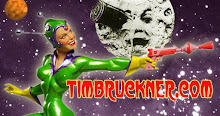
I’ve been thinking about how to introduce my friend, Tony Cipriano. I’d thought about extolling his virtues as an artist. I’d considered mentioning his genuineness. His down to earth, easy-going, joyful spirit. Maybe touch on his steadfastness as a friend, his loyalty and integrity. I could have opened with his compassion; he is a true blue dog lover and a man on intimate terms with Mother Nature. (Its okay, his wife knows). His devotion to old TV shows and classic movies, in particular, horror movies that open with a miniature plane circling a rotating globe. A die hard Beatles fan and the only other guy I know who listens to the Beau Hunks and their impeccable renditions of music from Laurel and Hardy and Little Rascal films. But, I suppose it makes more sense here, to discuss Tony, the sculptor. There ain’t nothing Tony can’t sculpt. He thinks with his fingers. He doesn’t over analyze, doesn’t get bogged down in minutia. He sculpts until its right and when it is, and he’s done and moves on to the next piece. He’s not as well known as he should be. If reputation were a direct result of talent, Tony would have his own network prime-time TV show. But he’s a terrible self-promoter. He’s more concerned about maintaining a good relationship with his clients and the quality of his work. Help us spread the word about our reluctant star. Ladies and Germs, the first of a three-parter, Its my pleasure to introduce, Tony” here’s another fine mess you’ve gotten me into” Cipriano. - Tim Bruckner
So Tim asked me to 'blog' with him. At first, I thought it was a tropical drink. Or maybe some kinky activity left over from his 'free love' days. So I did a little research and found out that this 'blogging' is all the rage with the kids today. Apparently they like to ‘tweet’ each other, too. To each his own. But, since I owe much to these grand old men--Procopio and Bruckner--I had to give it a whirl. I've decided to show my twisted, convoluted approach to a statue from 'soup to nuts'. I don't know too many other sculptors who are dumb enough to bake a Sculpey sculpture 20+ times along the way... and have clay dust an inch thick on the studio floor and shelves, not to mention on me. My wife calls me 'Pigpen', from the Peanuts cartoons...only my dust cloud is pink. (make your own jokes). Along the way, I'll go through several different materials, a dozen tubes of super glue, found objects, waste expensive silicone, and typically burn myself with boiling wax or slice off a fingertip or two. In short, I can't, in good conscience, recommend you follow my process…but maybe a tidbit here and a snippet there will apply for you. I hope you will take some useful info from this essay, but please save your laughter till I've left the building? Deal?
The sculptures I will be chronicling for this entry are the GAMBIT Premium Format Figure, and the SILVER SURFER Comiquette produced by Sideshow Collectibles. These are two recent projects and I worked on them simultaneously. SS's 'Premium Format' line consists of larger, 1/4 scale figures...mostly sculpted, but having some type of mixed media element added...like leather, fabric, etc. In Gambit's case, it was decided to sculpt most of his body, and add a 'real' trench coat. The SURFER, also 1/4 scale, is fully sculpted.
When I am initially contacted to begin a project, either the client will present me with an initial concept sketch, or ask me to draw one. Sometimes we will brainstorm on the phone, but in both of these cases, the client had a specific pose in mind. With Gambit, I was sent some existing artwork for inspiration..... and for Surfer, they sent me some JPEGs of a model ( my art director!) in the pose they wanted. ( FIG. 1) Most producers do not go the extra mile like this. It really makes my job easier. Using the photos of the model, I did a small drawing of the proposed statue from 2 angles. This was used to show to the licensor ( Marvel, in this case) and get a green light before we began sculpting. (FIG. 2)


The sculptures I will be chronicling for this entry are the GAMBIT Premium Format Figure, and the SILVER SURFER Comiquette produced by Sideshow Collectibles. These are two recent projects and I worked on them simultaneously. SS's 'Premium Format' line consists of larger, 1/4 scale figures...mostly sculpted, but having some type of mixed media element added...like leather, fabric, etc. In Gambit's case, it was decided to sculpt most of his body, and add a 'real' trench coat. The SURFER, also 1/4 scale, is fully sculpted.
When I am initially contacted to begin a project, either the client will present me with an initial concept sketch, or ask me to draw one. Sometimes we will brainstorm on the phone, but in both of these cases, the client had a specific pose in mind. With Gambit, I was sent some existing artwork for inspiration..... and for Surfer, they sent me some JPEGs of a model ( my art director!) in the pose they wanted. ( FIG. 1) Most producers do not go the extra mile like this. It really makes my job easier. Using the photos of the model, I did a small drawing of the proposed statue from 2 angles. This was used to show to the licensor ( Marvel, in this case) and get a green light before we began sculpting. (FIG. 2)


Once the concept sketch was approved, and the OK was given to proceed, I decided that it might be a good idea to work out some of the kinks on Silver Surfer in a small, oil clay maquette. Gambit was a straight forward, standing pose, but Surfer was to be on a 22 inch surfboard... banking into a turn... with trails of 'cosmic dust' behind him and supporting the 18 inch figure. So, I made a quick 1/8th scale model. ( FIG. 3) Once I began work on the larger version, this little 'study model' would eliminate all the guess work, making the project go much faster. This figure is only about 8 inches whereas the actual product will be an 18 inch figure.


For these 18-inch figures, I am using 1/4 inch armature wire. I like it because it is firm enough to hold up my figures, but it is a pain in the neck to cut through later. I suppose a more organized sculptor can plan ahead for cutting up a figure, but as I say....LAZY. I'm working in Super Sculpey. I had some gray for Gambit, but frankly I prefer the softer pink. The gray is harder, drier & takes detail better, but the pink is faster to work. Here is the Gambit figure blocked with the gray ( FIG. 4 ) I squeeze my clay on fast....pushing, scraping with the loop tool....raking...mashing. My first and foremost concern at this stage is that pose. I want it to be dynamic even if the figure is simply standing upright. You'd be surprised at how much of a difference even the slightest head tilt, shoulder dip, or finger bend can make. Even as rough as this is, it has already been baked several times to lock in the pose. You can see the light gray areas where I had to patch the cracks form the baking process. I've also used my grinding tool to actually 'sculpt' some forms. I use a barrel/drum bit on my Dremel, to sand the figure and break it down into planes. This may be my favorite part of the entire process. I can already tell at this point if I have a successful pose or not. Many times, I break the limbs and re-position them, using Magic Sculpt Epoxy.
I love this stage, because I'm not noodling it...I'm not worried about the tiny details yet. I can just sand, grind, slap clay on. I think it is the promise of what is to come that excites me. In other words, I haven't screwed it up yet! : )

I love this stage, because I'm not noodling it...I'm not worried about the tiny details yet. I can just sand, grind, slap clay on. I think it is the promise of what is to come that excites me. In other words, I haven't screwed it up yet! : )

Here is the first pass on the Surfer. ( FIG. 5) This is a little bit further along from the 'Dremel' stage. I have begun to add anatomy. Notice the light gray areas. This is Magic Sculpt epoxy, used to putty cracks and add keys to the arms & legs, which have already been separated for molding.


Another round on Gambit. I've begun to add some anatomy to his chest, separated the parts, and begun to actually draw with pencil where the costume details will go. The staff is only a wood dowel, but later will be replaced with brass stock. This statue comes with 2 alternate heads...one depicting the classic look, and one with the more modern incarnation of the character. ( FIG. 6) You can see how much I rely on the epoxy putty in the early stages. This is mostly due to the cracking that occurs with baking the Sculpey so many times. I know some sculptors will use a heat gun to cure small areas, but I never like to use a heat gun. It cures things unevenly and sometimes burns it. This is also why I like to separate the different components early on; I can bake parts while I continue to work on other parts of the sculpture. ( FIG. 7)


And another round on Surfer. ( FIG. 8 ) Since the last pass, I have sanded and primed the figure and continued work on the cosmic dust trail. The middle image shows a quick Photoshop area where I was showing the client what I planned to do to the dust. The client wisely requested that I raise the tip of the surfboard upwards. I think it made a huge difference. This is one of those things that happens when a sculptor works alone in his studio, and looks at the sculpture for days at a time. You begin to get 'tunnel vision'. It's extremely important to have art directors who know their stuff, take a look at the work many times along the way to catch things like this. Compare the difference to the earlier photos; much more dynamic & in keeping with the character. At this point the dust trail is just epoxy putty, stippled with tools.

In these shots (FIG. 9), you can see the new board. I cut 1/4 inch Masonite and carefully cut strips of thin styrene, gluing them down to the top and bottom.


In these shots (FIG. 9), you can see the new board. I cut 1/4 inch Masonite and carefully cut strips of thin styrene, gluing them down to the top and bottom.





































